Laos’ Plain of Jars. More like a bunch of Plain Jars. Yeah, that’s a pretty bad joke, but it’s an honest observation.

This mysterious site in northeastern Laos attracts the curiosity of thousands of people annually. If you find yourself in Laos, wondering where to venture next, you will notice the Plain of Jars pop up in search results, brochures and in tour offices.
The Plain of Jars main site is located near Phonsavan, Laos. With thousands of jars spread over hundreds of square miles, there are too many sites to count.
These mysterious stone “jars,” some very large and all probably quite heavy, are the subject of several theories and local legends. Locals say they were used to drink whisky by ancient giants. Anthropologists say they were used for burial purposes. Others (probably) point to little green guys from outer space. Despite the various ideas on the how, the question of importance for you is simpler: Should you go?
Here are some important factors to consider:
The Road to Phonsavan
The road to Phonsavan is not for the faint of heart. Hairpin turn after hairpin turn, winding for hours through mountains on roads with, at times, a thousand foot drop steps off the pavement.
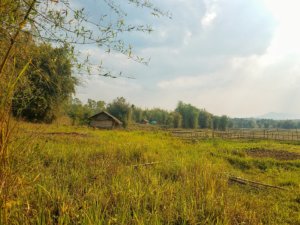
If car sickness is something you experience, you should remove the Plain of Jars – and much of SE Asia, for that matter – from your itinerary. Sure, there are always flights to be taken, but for any budget or long-term traveler, this is often not an option. Eventually, you will have to get on those winding roads. And don’t expect a lovely rest stop or a 7-11 to stretch your legs and grab a Coke. Stops are few and rustically third-world.
The views are beautiful at the right time of year. Sadly, as agricultural practices in Laos still rely heavily on slash-and-burn methods, smoke fills the skies and obstructs views for several months a year. Simply put, the road to Phonsavan is rough.
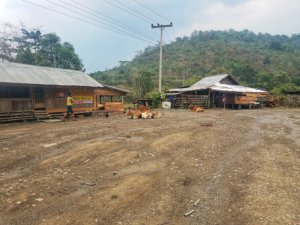
For those who can get past the eminent danger and discomfort, these bus rides in Southeast Asia are pretty cool.
Okay, so you have the time, stomach and the nerve. Your curiosity is piqued. Now, is Laos’ Plain of Jars worth the trip? In short, no.
Long Way Out
Looking at a map, Laos’ Plain of Jars appears to be on a fairly direct route from the charming tourist-hub of Luang Prabang or Vang Vieng, the former infamous party town and present popular outdoors destination.
Maps can be misleading. Each of the aforementioned cities is about a 150-mile trip to Phonsavan. A distance that takes a couple of hours in more developed places takes a full day in Laos. The lack of infrastructure simply makes Laos’ Plain of Jars a lot further away than it seems. The 7-hour ride easily stretches longer. A dozen hours on mountainous Laos roads – and, of course, packed like sardines in a bus that is filled far beyond a safe and reasonable capacity – does a number on the body.
**A personal warning to large travelers. I am a 250+ pounds, 6’3” traveler. I expect to be uncomfortable, especially in Asia, but some journeys are exceptionally tough.
If these ancient rock jars were just outside of Vientiane or Luang Prabang – even a couple hours! – this would be an easy choice to make the half-day trip. Unfortunately, the amount of time required to reach the sites for a pretty boring day of jar-hopping is not worth the time or money.
One Site is Enough
Once you have seen Jar Site 1 – the big one with the tourist office and museum – you have seen enough. Going through the museum in 20 minutes, you can read everything you need to know about the site. Other sites are essentially the same thing, just throw in some trees.
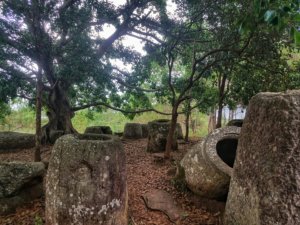
An hour walking through this large site of jars is sufficient, taking photos and enjoying decent views atop the hills.
Take note: once you have seen one site, you will get the idea. The other sites are the same. Some sites in the woods, some on hills, still big stone jars. Unless you dabble in anthropology, pass on the other sites.
Phonsavan, Nothing Else to Do
Phonsavan is okay. But that’s all, just okay. Aside from a humdrum visit to see the jars, there is not much else to do here. There are very few dining options. None are worth specifically mentioning, and some, considering the location in a remote, dusty town in Northern Laos, are bewilderingly expensive.
Phonsavan does have a great market. Sitting just behind the main road of the city is one of the most interesting markets I have seen – and that is a lot of markets. The Phonsavan Market is the Lao version of Wal-Mart. It has everything. Meat, produce, pastries, baskets, electronics, clothes and more. Best of all, the market has a lot of local specialties. There are local fruits and veggies, of course, and even some strange local items, like trutle shells, roots galore and strips of buffalo hide. My personal favorite feature are the local spices for sale.


There is a mulberry and silkworm farm that draws international attention. The methods of farming, production and dyeing are absolutely fascinating. The farm aims to help local women through employment, teaching silk production and providing a place for the women (mainly from rural, poor areas) to work and sell their goods.

Unfortunately, these places fall short in offsetting the painstaking journey to lure a traveler to Phonsavan. It will take more than a cool market and an interesting silk farm to make a visit to Laos’ Plain of Jars more enticing.
Watch Your Step
Laos’ Plain of Jars is right in the middle of a war path. While war was raging in Vietnam, over TWO MILLION TONS of bombs – more than all bombs dropped in World War II COMBINED – were dropped in Laos. Not Vietnam, Laos. Most bombs targeted the Ho Chi Minh Trail supply line or North Vietnamese combatants escaping to Laos. Other bombs were unloaded so the planes could conserve fuel and land safely (according to a local museum).
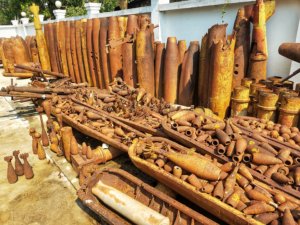
Millions of bombs landed without exploding. Nearly 50 years after the bombing came to a halt, thousands of people have died – and people continue to die each year – from these latent bombs.
The Plain of Jars lies in the middle of the danger zone. There are visible bomb craters at some of the sites, while workers attempt to clear nearby fields, foot by foot. Some of the sites have warning signs to caution visitors not to stray beyond cleared paths.
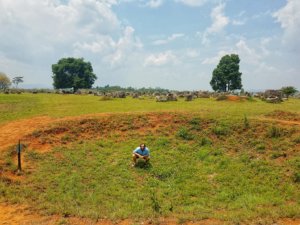
Wandering off the beaten path is a fun part of travel, but it is best to exercise caution and heed the warnings when visiting Laos’ Plain of Jars.
The Future is Bright
I believe the future is bright for Phonsavan. Barring some unfortunate turn of events – and, God forbid, another pummeling by foreign wars – Laos’ Plain of Jars has all the right ingredients to boost the local area.
Currently, the site is not a UNESCO-designated site. This is good for visitors right now, as you can wander freely, get up close and even touch the ancient stone objects.

Eventually the Plain of Jars is likely to receive UNESCO status and things will change. Precautionary measures will be taken to ensure preservation. Development will expand. Ticket prices will increase.
These are all good things for the local economy.
With further international recognition, Laos’ Plain of Jars will draw more attention, tourists and money to Phonsavan. New hotels, restaurants and tour companies will open. Hopefully, infrastructure will improve; if it does, Phonsavan’s status as a tourist destination will expand to travelers who visit for more than the Plain of Jars. There are a lot of natural wonders in the area which will be popular for travelers and lucrative for locals.
In time, it is likely that Phonsavan will become a popular destination in Laos.
Laos’ Plain of Jars is a place worth seeing IF it is already on your route. The route is pretty for those who can handle it and interesting for curious window watchers. However, it is not worth traveling hours – in the end, days – to explore a field. The Plain of Jars Wikipedia article does an adequate job of taking you there.
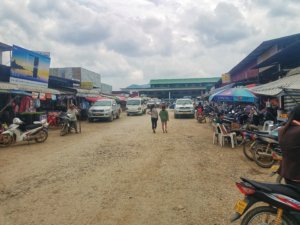
With little else to do in Phonsavan, and worst of all, mediocre (at best) food, skip this on your trip to Laos. Spend the extra time wandering in Vientiane, relaxing in 4000 Islands or taking pictures in Luang Prabang. Laos is a fascinating country, but the Plain of Jars is something to skip for now.
Leave a Reply
You must be logged in to post a comment.